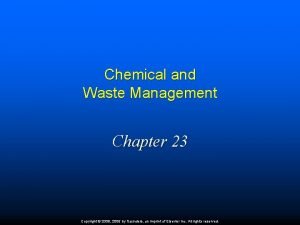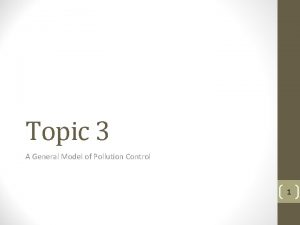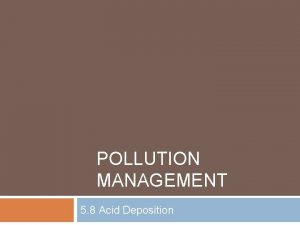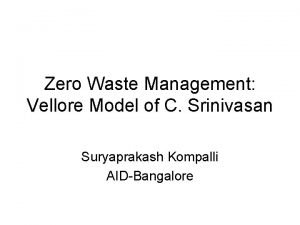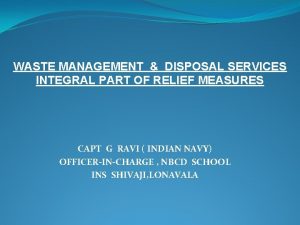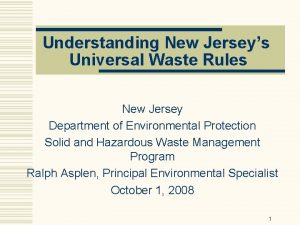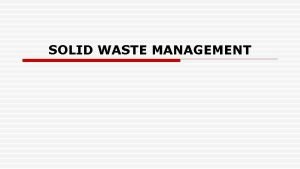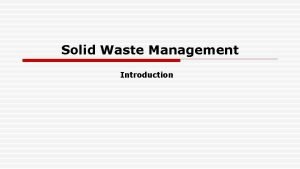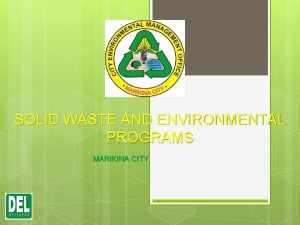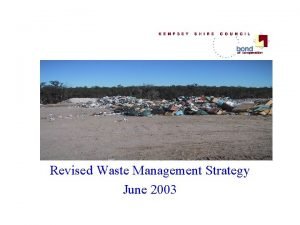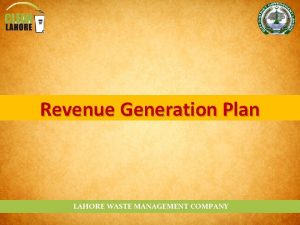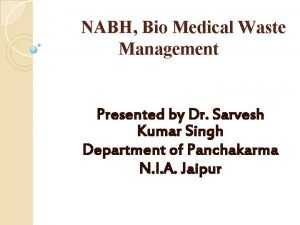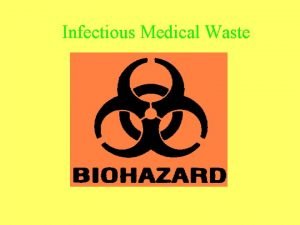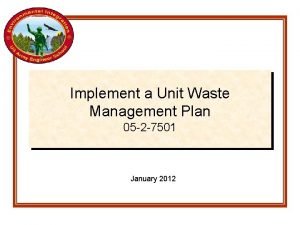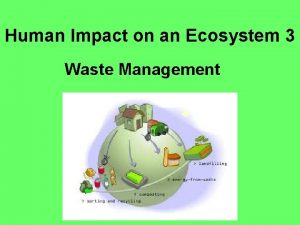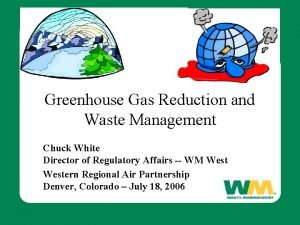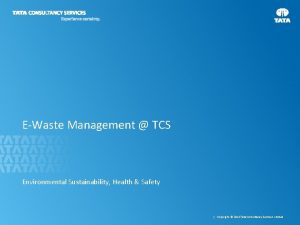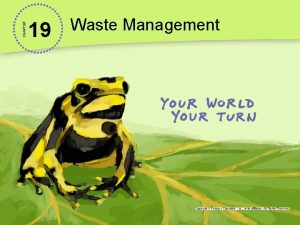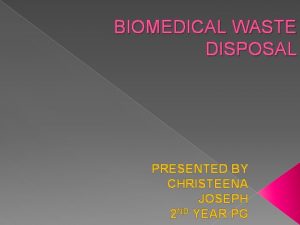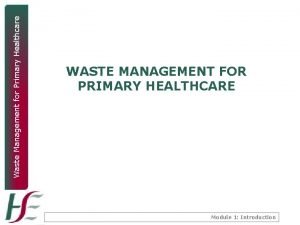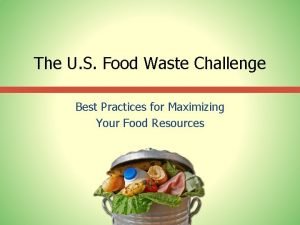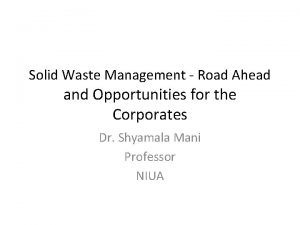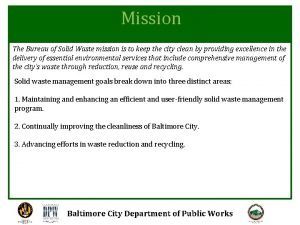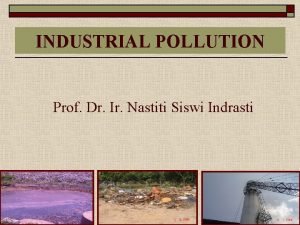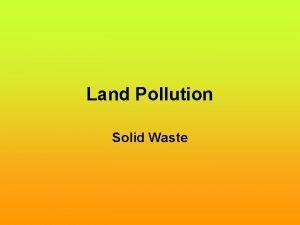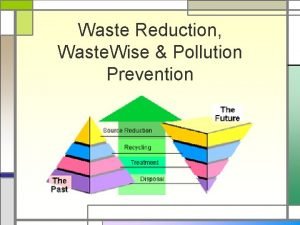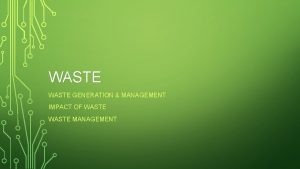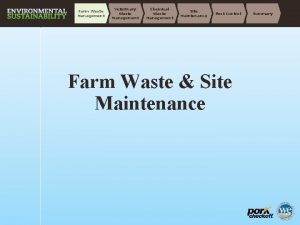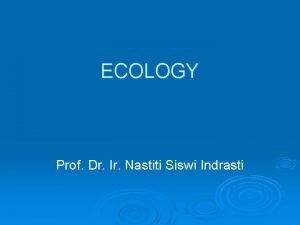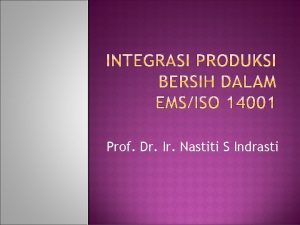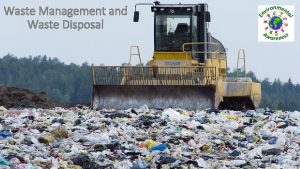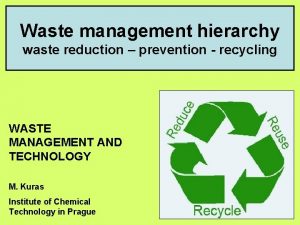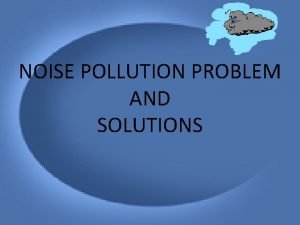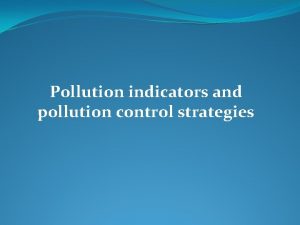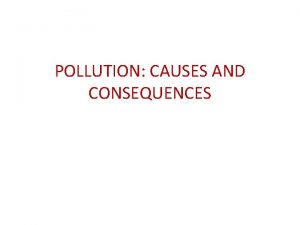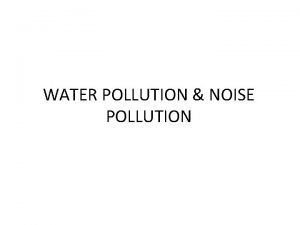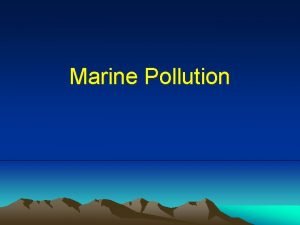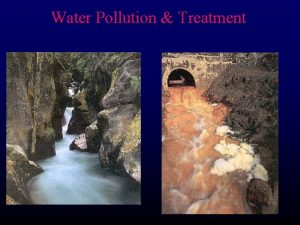POLLUTION AND WASTE MANAGEMENT Prof Dr Ir NASTITI


























- Slides: 26

POLLUTION AND WASTE MANAGEMENT Prof. Dr. Ir. NASTITI SISWI INDRASTI

Content list l l l l l A brief history of pollution and waste problems Pollution and waste associated with urbanization Industrial waste and pollution (non-radioactive) Radioactive waste and pollution Electromagnetic radiation (non-ionizing) Coping with pollution and waste Agricultural pollution and waste Recycling and re-use of pollution and waste Recommended reading

Definition l Pollution can be defined as introduction by humans, deliberately or inadvertently, of substances or energy (heat, radiation, noise) into the environment – resulting in deleterious effect. l Contamination is the presence of elevated concentrations of substances in the environment, food, etc. which not necessarily be harmful or a nuisance. l Pollution involves contamination, but contamination is not pollution

Pollution and Waste Management Strategies l Prevention l Reclamation l Disposal

A Hierarchy Of Environmental Management l Reuse l Waste reduction l Recycling l Resource recovery l Incineration l Landfill

A Brief History of Pollution and Waste Problems l Increased release of information on pollution and waste risk and nuisance-as a result of government, NGO, media and international agency activity l l The polluter-pays principle, NIMBY and NIABY Improved legislation to define, monitor, control pollution and waste l Spread of better environmental quality standards l Development of better policing, and of self-regulation and joint agreements between regulators and potential polluters. l Better methods and equipment for monitoring and assessment

Pollution and Waste Associated with Urbanization l l l l Heat-island effect Urban sprawl Urban storm run-off Domestic refuse Lead pollution Smog Public health-related pollution

Heat Island Effect l Built up land has a different heat storage characteristics, and roughness than nonurban, and there may also be considerable waste heat from homes and industry-these combine to cause a heatisland effect.

Urban sprawl l The FAO estimated that world-wide between 19802000 about 1, 400 million ha to arable land would be lost through urban sprawl (WRI, IIED, UNEP, 1982: 42) l Most cities have considerable areas of derelict land which could be used to reduce demand for new land, but to decontaminate and rehabilitate it for settlement can be costly although it can be relatively cheaply converted to amenity areas by tree planting and landscaping (which reduces the heat-island effect)

Urban Storm Run-off Drains and sewers speed up run-off sewage, silt and contaminated storm waste from cities. l Leaking sewerage contaminates ground water beneath a city. l problems associated with water-borne sewage disposal: l l l The cost of installing, extending and maintaining sewerage Failure to separate storm water, sewage and industrial waste, which makes treatment and disposal more difficult Waste often scarce water Treatment of sewage before discharge, which is seldom satisfactory

Domestic refuse Domestic waste is mixture l Non-degradable plastics and metal foil l In the developing countries refuse is likely to contain less packaging and more organic matter, so it may be easier to compost or generate methane, but more difficult to compress or incinerate l Sometimes domestic refuse is mixed with industrial wastes (co-disposal) and power-station flue-ash or sewage. l

Lead pollution About 90 % of the atmospheric lead is probably from leaded petrol. l lead reduces birth weights and children are vulnerable as they accumulate the metal and may suffer retarded mental development, especially if exposed in the early years of life. l Lead may be compounded in drinking water contaminated by old plumbing, and ingestion of white lead from old paint. l Some countries, starting in 1972, have insisted on the use of non-leaded petrol. l

Smogs l Sulphur dioxide-rich winter smog problems caused by domestic coal fires l There has been a world-wide increase in warm weather nitrogen dioxide-rich (photochemical) smog, mainly caused by petrol-engine vehicles. l Other emission are caused by vehicles in urban areaspartially burnt hydrocarbons including the dangerous volatile organic carbons (VOCs) which include toluene, ethylene, propylene, benzenes, toxic dust, heavy metals (notably lead), and noise. l VOCs are formed mainly from diesel exhaust, cause respiratory diseases and may be carcinogenic, play a part in tropospheric ozone production and acid deposition

Public Health-related Pollution l Pesticides are widely used by city health authorities to control mosquitoes, flies, lice, ticks, rats, etc. l Safer alternatives that might be used more widely to reduce pesticide applications: net screens on windows. l Application of small quantities of oil or kerosene to standing water to prevent mosquitoes reaching maturity, stocking water bodies with mosquito- or snaileating fish, trapping rodents, enforcing laws that prevent pest-breeding sites

Industrial Waste and Pollution (Non-radioactive) l Pollution and wastes are produced during extraction and processing of raw material transportation, manufacture, product use and disposal. l The pollution or waste may be gaseous, particulate, liquid, debris, radiation, heat, light or noise, waterborne waste and solid waste (large particles) are more easily intercepted and managed.

Sulphur dioxide and acid deposition l Pollution from thermal power stations and industry can effect the environment at considerable distance off-site, one impact being acidification. Acid deposition can be in the form of snow, mist or cloud droplets (wet deposition), or as dust, aerosols or gases, especially sulphur dioxide (SO 2) (dry deposition). l Acid deposition may: l l l Damage plants and animals directly Alter soil chemistry or structure Alter plant metabolism or species diversity of soil microorganisms, leading to change in fertility or soil chemistry Damage man-made and natural structures Mobilize compounds in soils, waste dumps and water (notably, phosphates, heavy metals, aluminum).

Radioactive waste and pollution l Natural radon emissions can damage human health, l Production of uranium, plutonium and other (unnatural) radioactive materials has contaminated miners, enrichment plant workers and the global environment, especially through atomic weapons testing, military and civil nuclear power plant accidents and contamination from industrial and medical isotope sources l Radioactive waste can be highly hazardous and very long-lived (with half-lives of thousands of years) stored high level wastes generate heat and gas pressure that damage their containment and radiation may also corrode containers l Nuclear waste can be stored in shallow or deep repositories, land filled, discharged into rivers or the sea, pumped down deep boreholes, dumped in containers in deep ocean, or reprocessed

Electromagnetic radiation (non-ionizing) Electromagnetic force (EMF) emissions are produced by microwave ovens, radar transmitters, household power cables, radio and tv- broadcasting, telecommunication equipment, computers and highvoltage transmission lines. l Epidemiological studies in the USA and by the Swedish national board for industrial and technological development suggest high-voltage power cables might cause childhood leukemia, cancer and brain tumors l EMF should be treated seriously. It may prove necessary to shield equipment much more carefully and to zone land use to keep transmission lines and housing apart l

Coping with pollution and waste l Hazardous pollution and waste l illicit dumping and export of waste and pollution l Less hazardous pollution and waste

Hazardous pollution and waste l Hazardous pollution and wastes can be grouped as chemical hazards, bio-hazards, radiation hazards. In addition, emergency services and health and safety planners, usually recognize explosives and fire hazards.

Illicit Dumping and Export of Waste and Pollution l Illegal waste disposal is a problem. l The export of hazardous substances to where having weak condition in regulations, labor cost and public resistance are most favorable. l There are two ways: l 1. A factory can be relocated in a developing country, or a subsidiary company can be established; l 2. Waste or pollutants can be shipped for disposal. l Hazardous processes are transferred to a less developed country, employees and local people may not appreciate the risk, or may be forced by circumstances to accept them in return for employment

Less Hazardous Pollution and Waste A lot of less hazardous waste is sent to shallow landfill l Less hazardous waste may develop into something threatening after burial as packaging, inks; decompose, mix, react, and perhaps leach to the groundwater or streams. l Well-engineered, carefully sited and managed landfill with the risk of leach ate ; or incineration with risk of air emissions l

Agricultural pollution and waste l Chemical fertilizers l Pesticides l Agricultural wastes l Livestock waste l Silage effluent l Brush clearance l Agricultural products processing waste

Recycling and Re-use of pollution and waste l The re-use and remanufacture of waste materials l To recover useful materials and save resources l To prevent pollutants reaching the waste stream l More efficient resource use, lower energy consumption, reduced pollution

Recommended reading l Journals which publish articles on environmental management of waste and pollution l Ambio l Archives of environmental contamination and toxicology l Atmospheric environment l Biogeochemistry l Environment and planning l Environmental monitoring and assessment l Environmental pollution l Environmental science and technology l Environmental toxicology and chemestry l Geochimica et cosmochimica acta l International journal of environmental and pollution l Journal of cleaner production l Journal of environmental management l Journal of the water pollution control federation science l Land degradation and development l Science of the total environment l Waste management l Water air and soil pollution l World waste

 Chemical and waste management chapter 23
Chemical and waste management chapter 23 Three level model of pollution management
Three level model of pollution management Pollution management strategies for acid deposition
Pollution management strategies for acid deposition C srinivasan waste management
C srinivasan waste management Recommendation on waste management
Recommendation on waste management Waste management chalmette
Waste management chalmette Universal waste examples
Universal waste examples Bakery waste management
Bakery waste management Principles of waste management
Principles of waste management Solid
Solid Solid
Solid Marikina garbage rules
Marikina garbage rules Waste management mission
Waste management mission Revenue generation plan
Revenue generation plan Sharp medical waste
Sharp medical waste Mebosha
Mebosha Waste management references
Waste management references 3 waste management
3 waste management Waste management (now wm) - wichita hauling
Waste management (now wm) - wichita hauling Environmental management system at tcs
Environmental management system at tcs Chapter 19 waste management answers
Chapter 19 waste management answers Introduction biomedical waste management
Introduction biomedical waste management Modern waste management technologies
Modern waste management technologies Hierarchy of waste management
Hierarchy of waste management Food waste management software
Food waste management software Waste management conclusion
Waste management conclusion Waste management conclusion
Waste management conclusion
